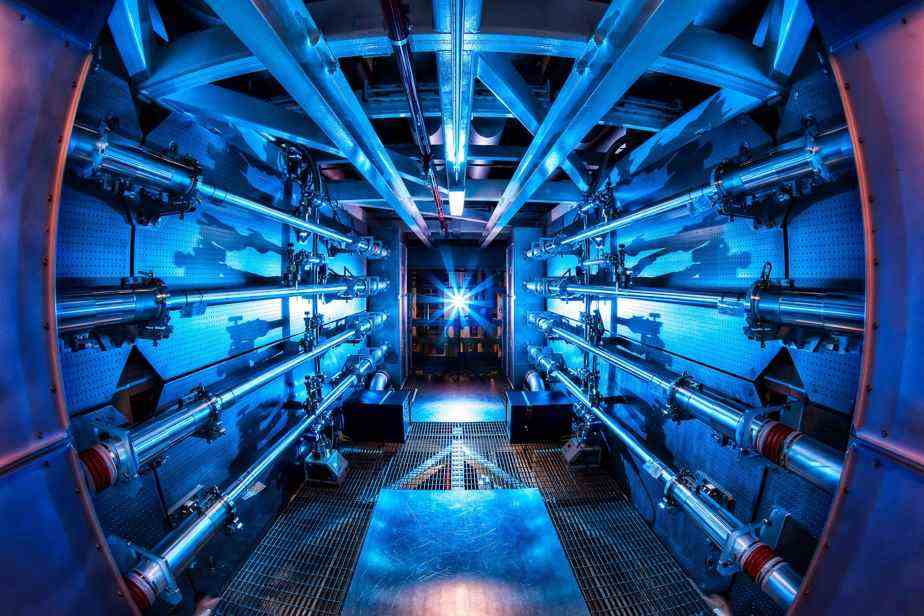(Washington) For the first time, researchers have succeeded in producing energy in the laboratory using nuclear fusion. A breakthrough that raises a lot of hope. But the large-scale production of zero carbon energy is not for tomorrow.
Hyperbola
A discovery worthy of the “history books”. A “monumental scientific breakthrough”. “A step towards abundant zero-carbon energy. The enthusiasm was palpable during the Department of Energy’s press conference Tuesday morning. Researchers at the National Ignition Facility (NIF) at Lawrence Livermore Federal Laboratory in California have succeeded for the first time in producing more energy with nuclear fusion than they injected into the reactor with lasers. More precisely, they produced 3.15 megajoules of energy by injecting 2.05 megajoules of energy in the form of ultraviolet rays with 192 lasers. Émile Knystautas, a physicist from Laval University who has worked on nuclear fusion, welcomes the announcement, but regrets the “a little dishonest” tone of the comments during the press conference. “Yes, it’s the first time, but we are very, very far from the goal. »

PHOTO PROVIDED BY LAWRENCE LIVERMORE LABORATORY, REUTERS ARCHIVES
The lasers converge on a capsule where the fusion of atoms occurs.
Scientific and engineering gain
The problem, Knystautas notes, is that to produce 2.05 megajoules of UV light required 100 times as much energy. “We have a net scientific gain, but if we look at the whole process, if we evaluate the ‘engineering gain’, we are very far from a gain,” explains Elliot Claveau, a graduate of Polytechnique Montréal who is doing his post-doctorate in nuclear fusion at the prestigious Massachusetts Institute of Technology (MIT). A year ago, the same NIF team announced that they had created 1.3 megajoules by injecting 1.8 megajoules. At this rate, it will take 20 years to arrive at a net engineering gain. “In fact, the NIF lasers are very old,” says Claveau. It is a laboratory that tests nuclear bombs. Current lasers are 20 times more effective. But we will also have to solve another problem: we can do this test at the NIF once a day, whereas to produce electricity commercially, we would have to do the operation with the lasers one to ten times a second. »

PHOTO PROVIDED BY ELLIOT CLAVEAU
Elliot Claveau, post-doctoral fellow in nuclear fusion at the Massachusetts Institute of Technology
The a bc of merger
Nuclear fusion is a dream of physicists because it does not produce nuclear waste, unlike current nuclear reactors, which are based on the fission of atomic nuclei, not their fusion. The risk of explosion is virtually zero. But the challenges are immense: we must recreate a process that takes place in the heart of the Sun, where there are pressures impossible to reach on Earth. “Humanity has achieved nuclear fusion with thermonuclear bombs, but it’s not controlled,” says Claveau.

INFOGRAPHIC THE PRESS
Two confinements
The experiment whose results were announced on Tuesday took place on December 5th. It used a different technique from most other reactors. “The nuclei of hydrogen isotopes that you want to fuse naturally tend to move away from each other, because they both have a positive charge,” says Knystautas. They have to be confined so that they stay close together and eventually fuse at very high temperatures. At the NIF we do inertial confinement. Initially, hydrogen isotopes are in solid form, at very cold temperatures. They heat up very, very quickly. Elsewhere there is magnetic confinement. The Varennes tokamak, a fusion reactor that operated until the late 1990s, used magnetic confinement, as did the European fusion megaproject ITER in Marseille.

PHOTO PROVIDED BY THE FACULTY OF SCIENCES AND ENGINEERING OF LAVAL UNIVERSITY
Émile Knystautas, Full Professor in the Department of Physics, Engineering Physics and Optics at Université Laval
The private merger
Several private groups, one of which is financed by Bill Gates and Jeff Bezos, are working in the United States on nuclear fusion projects. “There are about thirty private nuclear fusion projects,” says Mr. Claveau. Do they use magnetic or inertial confinement? “It’s either magnetic confinement or a hybrid form,” says Claveau.
Learn more
-
- 150 million degrees Celsius
- Temperature reached during the nuclear fusion experiment at the National Ignition Facility
SOURCE: National Ignition Facility
- – 255 degrees Celsius
- Temperature of hydrogen isotopes at start of fusion experiment
SOURCE: National Ignition Facility
-
- 3 billion US
- Amount of private investment in nuclear fusion since 2010
source : forbes
